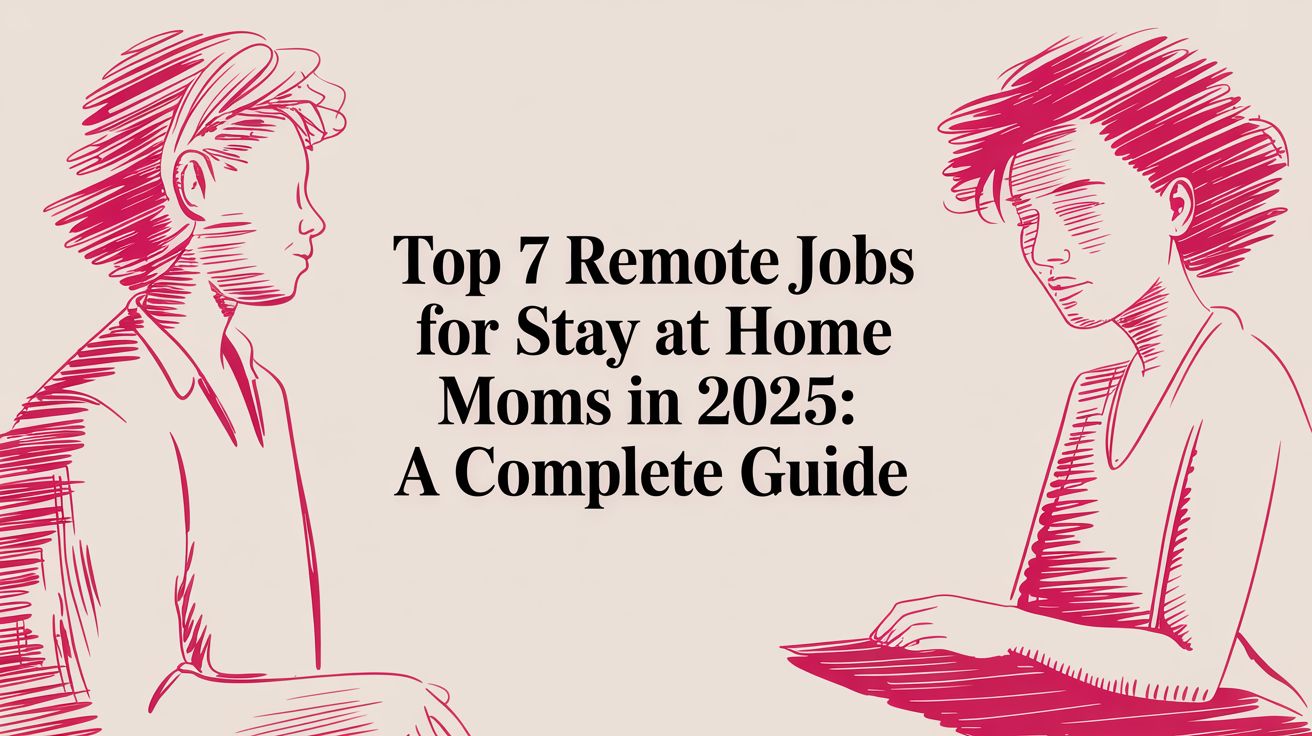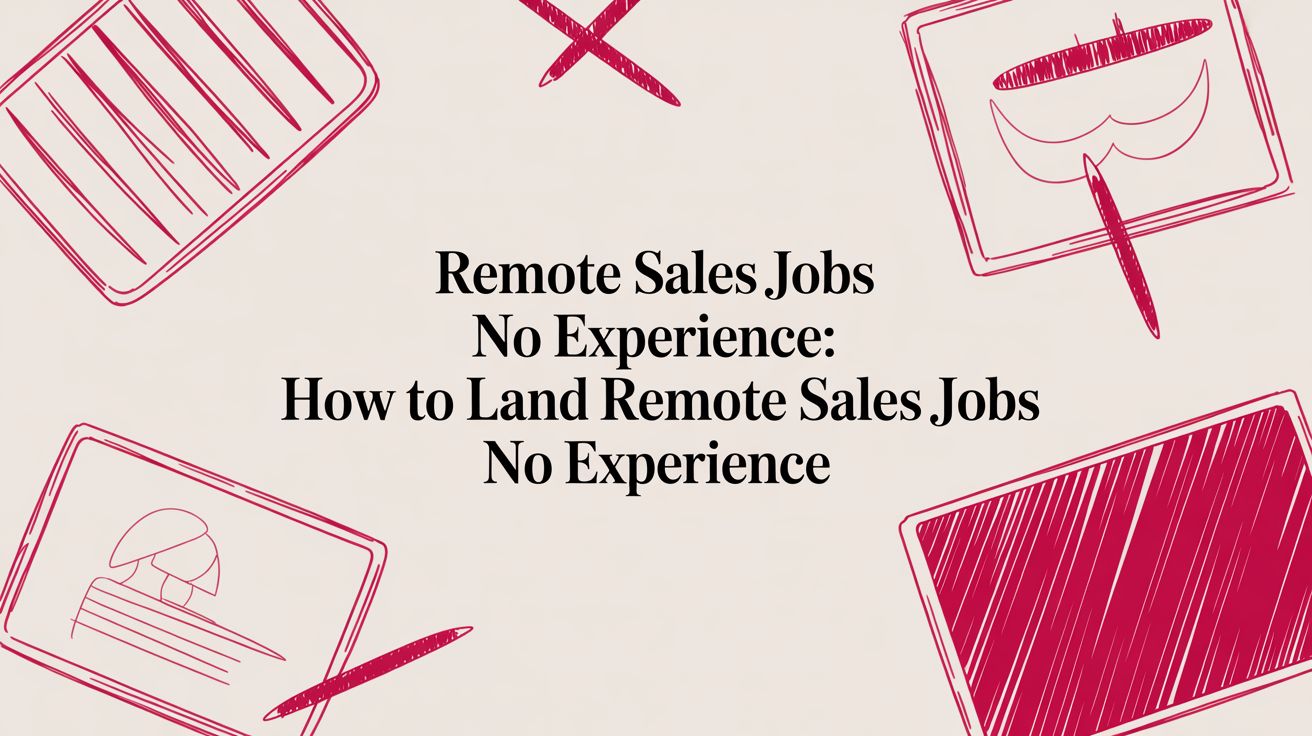productivity tips for working from home: boost focus
Max
The shift to remote work has transformed from a temporary measure into a permanent career path for millions globally. While the benefits like flexibility and autonomy are clear, mastering productivity in a home environment presents its own unique challenges that require more than just common sense. Generic advice such as ‘get dressed’ or ‘have a routine’ only scratches the surface of what it takes to perform at a high level. To truly thrive, you need a robust system built on proven strategies that create structure, eliminate distractions, and intentionally optimize your focus.
This guide moves beyond the obvious, delivering a curated collection of actionable productivity tips for working from home. We will break down specific techniques and tools designed to help you reclaim your time, produce high-quality work consistently, and maintain a healthy work-life balance. For a broader perspective on enhancing your remote work performance, you can also explore resources like these 10 Actionable Remote Work Productivity Tips. Whether you are a seasoned remote professional or just starting, the following strategies will empower you to build a more effective, structured, and fulfilling workday from anywhere.
1. Create a Dedicated Workspace
One of the most foundational productivity tips for working from home is to establish a physical space exclusively for your professional tasks. This area acts as a powerful psychological trigger, signaling to your brain that it’s time to enter work mode. By creating a clear boundary between your personal and professional life, you can more easily focus during work hours and fully disconnect when the day is done.
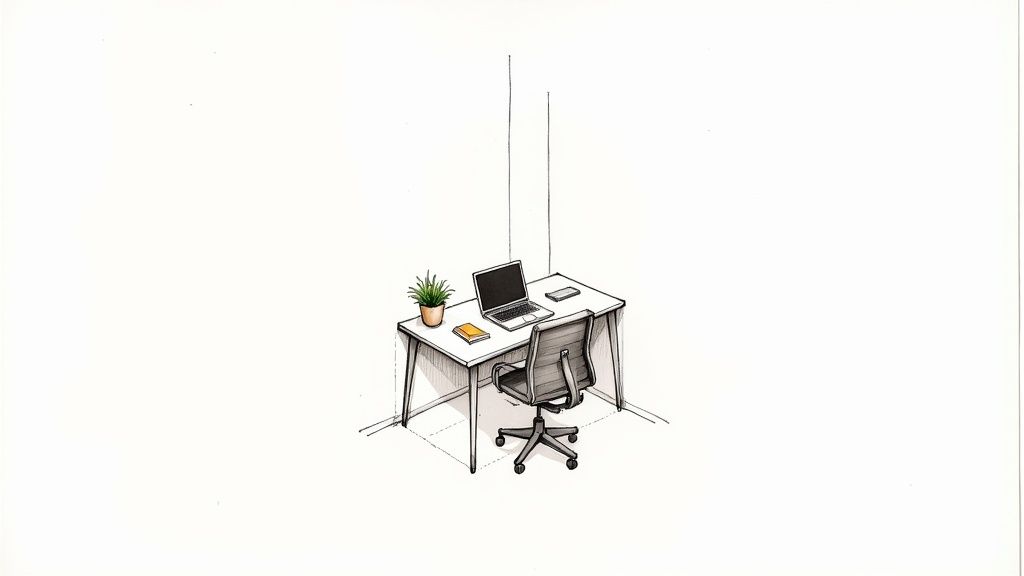
This dedicated zone doesn’t have to be an entire room. It can be a corner desk in a living room for a freelance writer, a converted spare bedroom for a software developer, or even a specific chair at the kitchen table that is only used for work. The key is consistency; this spot should be synonymous with your job.
### How to Implement This Strategy
To effectively create your workspace, focus on functionality and minimizing distractions. A well-designed area supports sustained concentration and physical well-being.
- Choose a Low-Traffic Area: Select a corner away from the main household activity, like a quiet spot in a basement or guest room.
- Invest in Ergonomics: Your long-term health is crucial. An ergonomic chair, proper desk height, and external monitor can prevent physical strain.
- Ensure Proper Lighting: Good lighting, preferably natural light, reduces eye fatigue and can boost your mood and energy levels.
- Stay Organized: Keep your desk clutter-free. Use organizers for papers, pens, and cables to maintain a clean and focused environment.
Creating this separation is essential for preventing burnout. When your workday is over, physically stepping away from your workspace helps you mentally “clock out,” preserving your personal time and improving work-life balance. For a deeper dive into optimizing your space, explore these expert guidelines on how to set up a home office.
2. Implement the Pomodoro Technique
One of the most effective productivity tips for working from home involves managing your time, not just your tasks. The Pomodoro Technique is a time-management method that breaks work into focused 25-minute intervals, known as “pomodoros,” separated by short 5-minute breaks. This approach leverages the psychological principle that frequent, short breaks can significantly improve sustained attention and prevent mental fatigue.
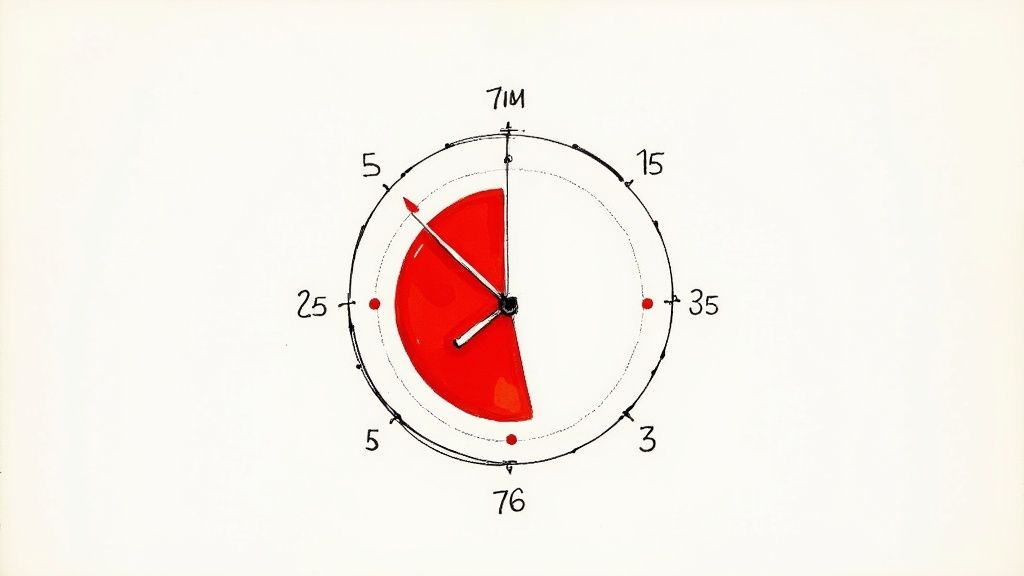
This strategy is incredibly versatile, used by students for exam prep, freelance writers to track billable hours, and even development teams for focused sprints. The structured intervals create a sense of urgency that discourages multitasking and procrastination, forcing you to concentrate fully on the single task at hand until the timer rings.
### How to Implement This Strategy
To successfully adopt the Pomodoro Technique, you need discipline and the right tools. The goal is to train your brain to work in intense, short bursts, making your work periods more effective.
- Choose Your Timer: Use a dedicated app like Forest or Be Focused, or even a simple kitchen timer. The physical act of setting a timer reinforces your commitment.
- Eliminate Distractions: During a 25-minute pomodoro, all notifications should be turned off. This is a non-negotiable period of deep work.
- Use Breaks Wisely: Your 5-minute break is for stepping away from your screen. Stretch, grab a glass of water, or walk around to reset your mind.
- Track Your Progress: Keep a log of how many pomodoros you complete each day. This visualization of your effort can be a powerful motivator.
By creating this rhythm of focused work and planned rest, you can sustain high levels of productivity throughout the day without succumbing to burnout. To explore this and other powerful methods, check out these strategies on how to improve time management skills.
3. Establish a Consistent Routine and Schedule
Transitioning to remote work without structure can quickly blur the lines between your professional and personal life. Establishing a consistent daily routine is one of the most effective productivity tips for working from home, as it creates a predictable framework that signals to your brain when to focus and when to relax. This structure helps manage expectations with colleagues, prevents overworking, and builds sustainable work habits.
This doesn’t mean your day must be rigid. It’s about creating anchor points, such as consistent start and end times, dedicated lunch breaks, and blocks for deep work. A consultant might set firm 9-to-5 hours for client availability, while a creative professional may structure their day around peak energy levels, dedicating mornings to writing and afternoons to administrative tasks. The goal is rhythm, not rigidity.
### How to Implement This Strategy
A successful remote routine is built on clear boundaries and intentional planning. By structuring your day, you take control of your time and proactively defend it against distractions.
- Set Core Working Hours: Define your start and end times and communicate them clearly to your team. This helps manage collaboration and prevents after-hours requests.
- Create a Pre-Work Ritual: Start your day with a routine that isn’t work-related, like a short walk, meditation, or reading. This helps you transition into a professional mindset before you even open your laptop.
- Use Time Blocking: Allocate specific blocks of time in your calendar for certain tasks or types of work. This ensures important projects get the focused attention they need.
- Schedule Your Breaks: Intentionally schedule short breaks and a proper lunch away from your desk. This prevents burnout and helps maintain high energy levels throughout the day.
By treating your remote workday with the same structure as an in-office schedule, you reinforce the mental separation necessary for long-term success and well-being. This approach is heavily advocated by remote-first companies like Basecamp, which emphasize the importance of routines for sustainable productivity.
4. Minimize Distractions and Manage Notifications
One of the most impactful productivity tips for working from home involves actively controlling your digital and physical environment. Research shows that it takes an average of 23 minutes to fully refocus after an interruption, making distraction management critical. By disabling notifications and creating interruption-free periods, you protect your most valuable asset: your focused attention.

This strategy isn’t about becoming unreachable; it’s about being intentional with your availability. For example, a software engineer might use a website blocker to prevent context-switching during a coding sprint, or a writer might disable all notifications to achieve a state of flow. The goal is to replace a reactive, always-on mode with a proactive, scheduled approach to communication.
### How to Implement This Strategy
To effectively minimize distractions, you must create a system that shields your focus from both digital and physical interruptions. This involves setting clear rules for yourself and communicating them to others.
- Use Technology to Fight Technology: Employ apps like Freedom or Cold Turkey to block distracting websites and applications during designated work blocks.
- Batch Your Communication: Instead of reacting to every ping, schedule specific times to check email and messages, such as 10 AM and 3 PM.
- Leverage “Do Not Disturb” Modes: Silence your phone, mute Slack channels, and turn off desktop notifications to create an impenetrable focus bubble.
- Communicate Your Availability: Use your Slack status to signal deep work (e.g., “In deep focus, checking messages at 2 PM”) and wear headphones as a physical “do not disturb” sign for household members.
This practice is essential for deep work, as popularized by author Cal Newport. By managing interruptions, you create the necessary conditions for producing high-quality, cognitively demanding work. For more insights on protecting your focus, explore these expert tips on how to set boundaries at work.
5. Use Time Blocking and Task Batching
One of the most effective productivity tips for working from home is to move beyond a simple to-do list and actively manage your calendar with time blocking and task batching. This method involves assigning a specific time slot for every task on your schedule, which eliminates decision fatigue and the cognitive cost of constantly switching between different types of work. By grouping similar activities together, you can maintain focus and leverage your momentum for maximum efficiency.
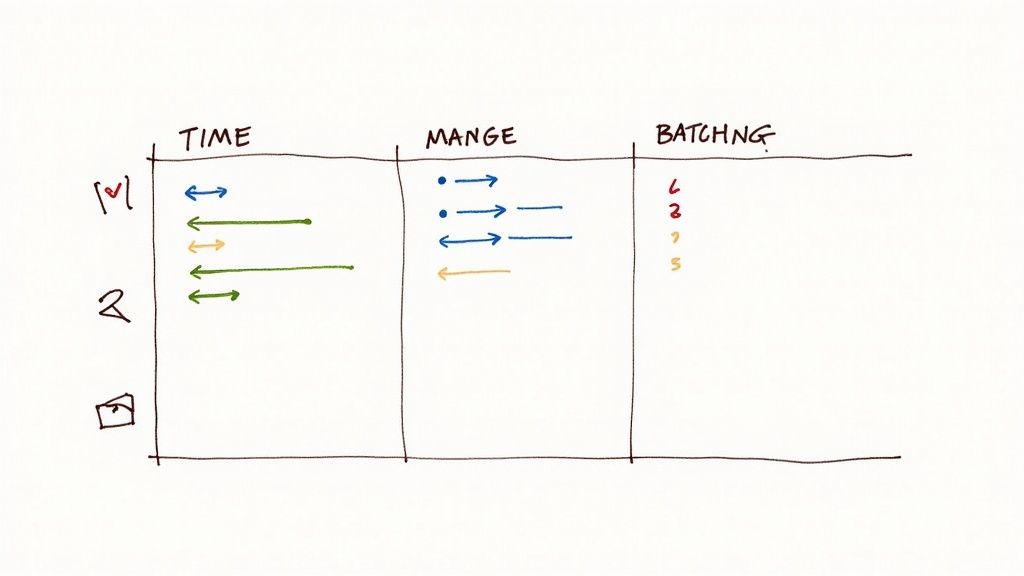
This strategy is about being intentional with your time. Instead of reacting to whatever comes up, you proactively dictate your day’s flow. For instance, a project manager might block 9-10 AM for administrative tasks and 2-3 PM for team check-ins, while a developer dedicates uninterrupted morning blocks to deep coding work, saving afternoons for meetings and code reviews. This approach ensures that high-priority tasks receive the dedicated attention they deserve.
### How to Implement This Strategy
To start using time blocking, analyze your typical workload and energy levels to build a realistic and effective schedule. The goal is to create a template that guides your week while remaining flexible enough for adjustments.
- Color-Code Your Calendar: Assign different colors to task categories like deep work, meetings, admin, and personal breaks. This visual cue helps you quickly assess your day’s balance.
- Batch Similar Tasks: Group all your email responses into two or three specific time blocks daily rather than checking them sporadically. Similarly, schedule all your meetings back-to-back to stay in a collaborative mindset.
- Schedule Deep Work First: Identify when your energy and focus are at their peak (often in the morning) and block this time for your most challenging, high-value work.
- Include Buffer Time: Add 10-15 minute buffers between blocks. This allows you to wrap up, take a short break, or handle unexpected small tasks without derailing your entire schedule.
Pioneered by productivity experts like Cal Newport, this method prevents multitasking and creates a clear roadmap for your day. By structuring your time this way, you gain control over your focus and consistently make progress on what matters most. For more on structuring your focus, read Cal Newport’s thoughts on his Deep Work philosophy.
6. Optimize Your Physical and Digital Setup
Your physical environment and digital organization are the twin pillars supporting your daily productivity. Investing in a setup that promotes comfort and efficiency minimizes friction, allowing you to focus on high-value tasks instead of fighting against distractions or discomfort. A well-designed physical space prevents strain and fatigue, while a streamlined digital system reduces the mental load of managing information.
This optimization goes beyond just having a fast computer. It encompasses everything from an ergonomic chair that supports your posture during long sessions to a logical file-naming system that lets you find any document in seconds. Companies often support this by providing stipends for home office equipment, recognizing that a well-equipped employee is a more productive and healthier one.
### How to Implement This Strategy
To effectively optimize your setup, address both the physical and digital aspects of your work environment. A holistic approach ensures that your body is comfortable and your workflow is seamless.
- Prioritize Ergonomics: Invest in a high-quality ergonomic chair and an adjustable-height desk. Position your monitor at eye level, about an arm’s length away, and use a separate keyboard and mouse to maintain a neutral wrist position.
- Enhance Your Digital Workspace: Organize digital files with clear, consistent naming conventions and folder structures in cloud storage like Google Drive or Dropbox. To truly maximize your screen real estate and boost multitasking efficiency, consider resources on connecting multiple monitors to your laptop.
- Upgrade Your Tech: Ensure you have a reliable, high-speed internet connection, especially during peak hours. Use project management tools like Asana or Trello to keep tasks organized and visible.
- Control Your Lighting: Use a mix of ambient and task lighting to reduce eye strain. Natural light is ideal, but a good desk lamp is essential for darker days or evening work.
Optimizing your setup is a direct investment in your long-term productivity and well-being. By creating an environment that supports you, you eliminate common roadblocks that drain energy and focus. For a closer look at the digital side, explore these essential tools for remote teams.
7. Set Clear Goals and Priorities Daily
To maximize your output when working from home, it’s vital to start each day with a clear sense of purpose. Defining a small number of high-priority tasks establishes your focus, preventing you from getting sidetracked by reactive, less important work. This approach provides a roadmap for your day, reducing decision fatigue and ensuring your efforts align directly with your most significant objectives.
This daily ritual transforms a long to-do list from a source of overwhelm into a manageable set of achievable targets. For a writer, the primary goal might be to complete 2,000 words. For a sales professional, it could be making five key client calls. The principle, popularized by authors like Brian Tracy in Eat That Frog, is to tackle what’s most important first, creating momentum and a sense of accomplishment early in your day.
### How to Implement This Strategy
Effectively setting daily priorities involves more than just making a list; it requires strategic selection and commitment. A disciplined approach ensures your daily actions contribute to long-term success.
- Identify Your “Big 3”: Each morning, before checking emails, write down the three most crucial tasks you need to complete. This sharpens your focus on what truly matters.
- Use a Prioritization Matrix: Categorize tasks using the Eisenhower Matrix, separating them by urgency and importance. This helps you identify what to do now, what to schedule, and what to ignore.
- Eat That Frog First: Tackle your most challenging or dreaded priority task first. Completing it builds momentum and makes the rest of the day feel more manageable.
- Leverage Technology: Use tools like Todoist or Microsoft To Do to track your daily goals. Seeing your priorities listed digitally can provide clarity and motivation.
By consistently setting and achieving daily goals, you build a powerful habit that significantly enhances your remote work productivity. This structured method helps you stay proactive rather than reactive, ensuring that you control your day instead of letting your day control you. For more on this concept, James Clear’s work on Atomic Habits offers valuable insights into building effective routines.
8. Take Regular Breaks and Practice Self-Care
Sustained focus isn’t about powering through long hours without interruption; it’s about managing your energy effectively. Taking intentional breaks and prioritizing self-care are essential productivity tips for working from home that prevent mental fatigue and burnout. By stepping away from your work, you give your brain time to reset, which restores focus, boosts creativity, and improves decision-making upon your return.
This practice is championed by leading companies like Google and Microsoft, which integrate wellness programs and mindfulness resources into their culture. For the remote worker, this could mean a short walk between meetings, a quick meditation session using an app like Calm, or simply eating lunch away from the desk. The goal is to create a genuine disconnect, allowing for both mental and physical rejuvenation.
### How to Implement This Strategy
Integrating breaks and self-care requires intentional scheduling rather than waiting for exhaustion to set in. A proactive approach ensures you maintain high energy levels throughout the day and week.
- Schedule Micro-Breaks: Use a timer to remind yourself to take a 5-10 minute break every hour. Use this time to stretch, walk around, or get some fresh air.
- Practice Mindfulness: Incorporate short mindfulness or meditation sessions into your day. Even five minutes can significantly reduce stress and improve concentration.
- Move Your Body: A sedentary work-from-home life can drain energy. Maintain a regular exercise routine and use breaks for physical movement like climbing stairs or doing a few yoga poses.
- Disconnect After Hours: Establish a firm boundary at the end of your workday. Create an evening wind-down routine that doesn’t involve screens to improve sleep quality, as detailed in books like Matthew Walker’s Why We Sleep.
By treating breaks as a non-negotiable part of your schedule, you invest in your long-term well-being and productivity. This proactive self-care prevents the slump that often follows prolonged periods of intense focus, ensuring you remain effective and engaged.
9. Track and Measure Productivity
To truly optimize your remote work performance, you need to move beyond guesswork and start making data-driven decisions. Tracking and measuring your productivity provides tangible insights into your work habits, helping you identify what’s working and what isn’t. This approach creates accountability and allows for continuous, informed adjustments to your workflow.
This doesn’t mean micromanaging every second. Instead, it’s about understanding the big picture. For example, a freelancer might use Toggl to ensure billable hours are accurate, while a marketing manager could use a dashboard to track project completion rates. The goal is to gather objective data that guides you toward more efficient and effective work patterns.
### How to Implement This Strategy
Start by choosing key metrics that align with your professional goals. The right tools and a consistent review process will transform raw data into one of the most powerful productivity tips for working from home.
- Use Time-Tracking Tools: Applications like Toggl, Clockify, or RescueTime can automatically track how you spend your time, revealing your most productive hours and biggest distractions.
- Identify Key Metrics: Don’t just track hours; measure outcomes. Monitor task completion rates, project milestones hit, or the ratio of deep work to shallow work (meetings, emails).
- Conduct Weekly Reviews: Set aside 15-30 minutes each week to analyze your data. Look for patterns, such as which days you are most focused or which tasks consistently take longer than expected.
- Adjust Based on Insights: Use your findings to optimize your schedule. If you’re most productive in the morning, schedule your most demanding tasks then. If meetings are eating your focus time, try to block them into a single afternoon.
By measuring your output, you create a feedback loop for improvement. To get started, you can explore a range of powerful tools and techniques with this guide on remote work time tracking.
9-Point Comparison: WFH Productivity Tips
| Strategy | Implementation Complexity 🔄 | Resource Requirements ⚡ | Expected Outcomes 📊 | Ideal Use Cases 💡 | Key Advantages ⭐ |
|---|---|---|---|---|---|
| Create a Dedicated Workspace | Moderate — planning, physical setup | High — space, ergonomic furniture, peripherals | Strong: improved focus, clear work/home boundaries | Full-time remote workers, developers, professionals needing privacy | Focus & work-life separation — ⭐⭐⭐⭐ |
| Implement the Pomodoro Technique | Low — simple rules and timer | Low — timer or app | Improved short-term focus, regular rest; may disrupt deep flow | Students, freelancers, tasks that fit 25‑min chunks | Easy to adopt; reduces procrastination — ⭐⭐⭐ |
| Establish a Consistent Routine and Schedule | Moderate — habit formation and discipline | Low — calendar/timeblocking | Predictable productivity, better sleep and availability | Those needing structure, teams across time zones | Consistency, reliability, reduced decision fatigue — ⭐⭐⭐⭐ |
| Minimize Distractions and Manage Notifications | Moderate — rules + enforcement | Low–Moderate — blocking apps, settings | Higher deep-work capability; fewer context switches | Knowledge workers, writers, engineers needing deep focus | Enables sustained deep work, reduces interruptions — ⭐⭐⭐⭐ |
| Use Time Blocking and Task Batching | Moderate — planning and calendar management | Low — calendar/tools (Notion/Google Calendar) | Reduced decision fatigue, higher throughput on grouped tasks | Managers, project-based workers, multitaskers | Improves efficiency and task completion rates — ⭐⭐⭐⭐ |
| Optimize Your Physical and Digital Setup | High — purchase/setup and config time | High — ergonomic gear, software, faster internet | Reduced physical strain, faster workflows, fewer technical delays | Heavy computer users, long-hour remote teams | Comfort + lower friction = sustained productivity — ⭐⭐⭐⭐ |
| Set Clear Goals and Priorities Daily | Low — brief daily planning habit | Low — list or task app | Better focus on high-impact tasks, visible progress | Individuals needing direction, PMs, salespeople | Clarity, alignment, measurable progress — ⭐⭐⭐⭐ |
| Take Regular Breaks and Practice Self-Care | Low — scheduling and commitment | Low — time for movement/activities | Reduced burnout, improved creativity and attention | High-stress roles, creatives, long-schedule workers | Sustains long-term productivity and wellbeing — ⭐⭐⭐⭐ |
| Track and Measure Productivity | Moderate — setup and analysis effort | Moderate — tracking tools, reporting time | Data-driven insights, identifies bottlenecks; may feel intrusive | Freelancers, managers, data-driven teams | Objective feedback for continuous improvement — ⭐⭐⭐ |
Build Your Sustainable Remote Work System
Navigating the landscape of remote work successfully isn’t about finding a single, revolutionary hack. Instead, true, lasting productivity comes from building a personalized and sustainable system that aligns with your unique professional demands, personal rhythms, and work style. The collection of productivity tips for working from home detailed in this article serves as a toolkit, not a rigid prescription. The real power lies in thoughtful experimentation and intentional design of your workday.
The strategies we’ve explored, from creating a dedicated workspace to implementing the Pomodoro Technique and mastering time blocking, are interconnected components of a larger ecosystem. A well-defined schedule is amplified by effective distraction management. Clear daily goals become achievable when supported by optimized physical and digital tools. Each tip builds upon the others, creating a powerful flywheel effect that transforms your work-from-home experience from reactive and chaotic to proactive and controlled.
From Tips to System: Your Action Plan
The key takeaway is that you are the architect of your own productivity. A system that works wonders for a creative designer might feel restrictive to a data-driven programmer. The goal is to move beyond simply reading these tips and start actively implementing them.
Here are your actionable next steps:
- Select and Start Small: Don’t try to overhaul your entire routine overnight. Choose one or two strategies that resonate most with your current challenges. If you constantly feel pulled in multiple directions, start with task batching. If your energy plummets in the afternoon, focus on scheduling meaningful breaks.
- Track and Iterate: Implement your chosen tip for a full week. Use a simple journal or a productivity app to track your focus, energy levels, and output. Ask yourself: Did this change make a positive impact? What adjustments are needed? This data-driven approach removes the guesswork.
- Build Your Stack: Once a new habit is established, layer on another. Perhaps you’ve mastered your morning routine; now, introduce a structured end-of-day shutdown ritual to create a clear boundary between work and personal life. Over time, these individual habits will coalesce into a robust, customized system.
Mastering these concepts is more than just about getting more done; it’s about reclaiming your time, reducing work-related stress, and unlocking the profound benefits of remote work: autonomy, flexibility, and a healthier work-life integration. By taking intentional control of your environment, schedule, and focus, you can cultivate a professional life that is not only highly productive but also deeply fulfilling. The ultimate goal is to create a work structure that serves you, enabling you to deliver exceptional results without sacrificing your well-being.
Ready to apply your newfound productivity skills in a role that truly values remote work? The best remote-first companies build their culture around the principles of trust and autonomy, empowering you to do your best work from anywhere. Explore thousands of vetted, high-quality remote opportunities on Remote First Jobs and find a company that aligns with your ideal work-from-home system.
